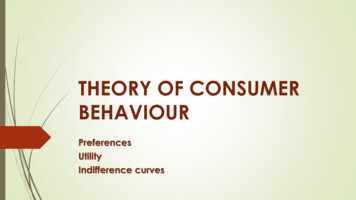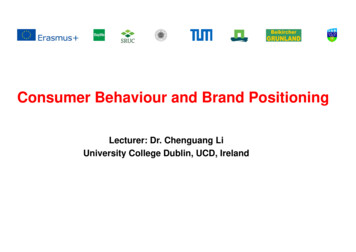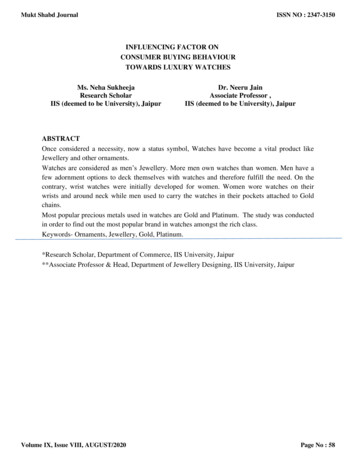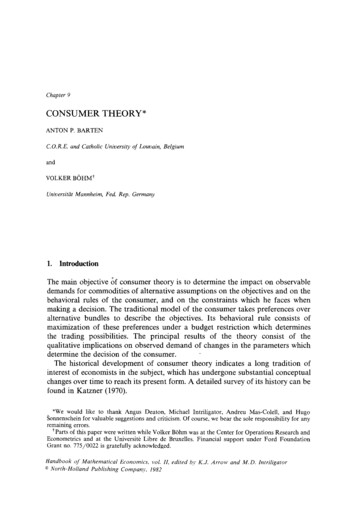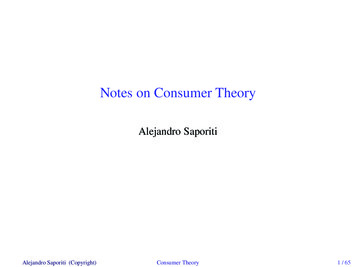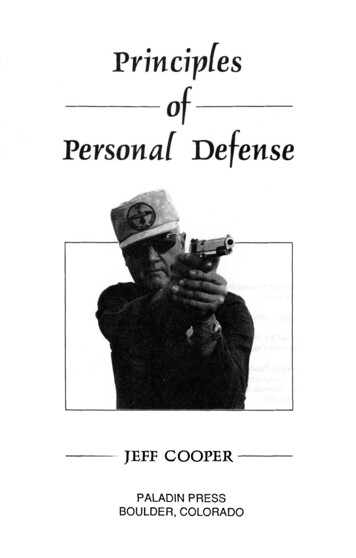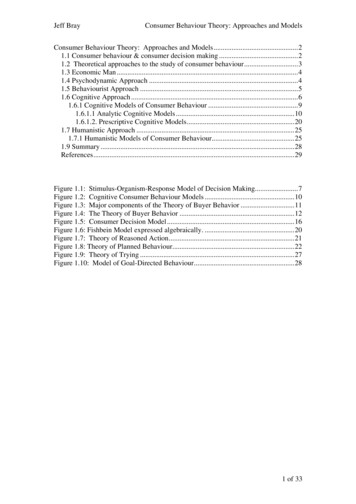
Transcription
Jeff BrayConsumer Behaviour Theory: Approaches and ModelsConsumer Behaviour Theory: Approaches and Models.21.1 Consumer behaviour & consumer decision making .21.2 Theoretical approaches to the study of consumer behaviour.31.3 Economic Man .41.4 Psychodynamic Approach .41.5 Behaviourist Approach .51.6 Cognitive Approach .61.6.1 Cognitive Models of Consumer Behaviour .91.6.1.1 Analytic Cognitive Models .101.6.1.2. Prescriptive Cognitive Models.201.7 Humanistic Approach .251.7.1 Humanistic Models of Consumer Behaviour.251.9 Summary .28References.29Figure 1.1: Stimulus-Organism-Response Model of Decision Making.7Figure 1.2: Cognitive Consumer Behaviour Models .10Figure 1.3: Major components of the Theory of Buyer Behavior .11Figure 1.4: The Theory of Buyer Behavior .12Figure 1.5: Consumer Decision Model.16Figure 1.6: Fishbein Model expressed algebraically. .20Figure 1.7: Theory of Reasoned Action.21Figure 1.8: Theory of Planned Behaviour.22Figure 1.9: Theory of Trying .27Figure 1.10: Model of Goal-Directed Behaviour.281 of 33
Jeff BrayConsumer Behaviour Theory: Approaches and ModelsConsumer Behaviour Theory: Approaches andModels1.1 Consumer behaviour & consumer decision makingConsumer decision making has long been of interest to researchers. Beginning about300 years ago early economists, led by Nicholas Bernoulli, John von Neumann andOskar Morgenstern, started to examine the basis of consumer decision making(Richarme 2007). This early work approached the topic from an economicperspective, and focused solely on the act of purchase (Loudon ANDDella Bitta1993). The most prevalent model from this perspective is ‘Utility Theory’ whichproposes that consumers make choices based on the expected outcomes of theirdecisions. Consumers are viewed as rational decision makers who are only concernedwith self interest (Schiffman ANDKanuk 2007, Zinkhan 1992).Where utility theory views the consumer as a ‘rational economic man’ (Zinkhan1992), contemporary research on Consumer Behaviour considers a wide range offactors influencing the consumer, and acknowledges a broad range of consumptionactivities beyond purchasing. These activities commonly include; need recognition,information search, evaluation of alternatives, the building of purchase intention, theact of purchasing, consumption and finally disposal. This more complete view ofconsumer behaviour has evolved through a number of discernable stages over the pastcentury in light of new research methodologies and paradigmatic approaches beingadopted.While this evolution has been continuous, it is only since the 1950’s that the notion ofconsumer behaviour has responded to the conception and growth of modernmarketing to encompass the more holistic range of activities that impact upon theconsumer decision (Blackwell,Miniard et al. 2001). This is evident in contemporarydefinitions of consumer behaviour:2 of 33
Jeff BrayConsumer Behaviour Theory: Approaches and Models“consumer behaviour is the study of the processes involved whenindividuals or groups select, purchase, use or dispose of products,services, ideas or experiences to satisfy needs and desires.”(Solomon,Bamossy et al. 2006, p6).(Schiffman ANDKanuk 2007) take a similar approach in defining consumerbehaviour:“the behavior that consumers display in searching for, purchasing, using,evaluating, and disposing of products and services that they expect willsatisfy their needs” (p.3).While most contemporary definitions of consumer behaviour are similar in scope,section 1.2 will identify and discuss the differing psychological approaches that havebeen applied to research in this area.1.2 Theoretical approaches to the study of consumerbehaviourA number of different approaches have been adopted in the study of decision making,drawing on differing traditions of psychology. Writers suggest different typologicalclassifications of these works with five major approaches emerging. Each of thesefive approaches posit alternate models of man, and emphasise the need to examinequite different variables (Foxall 1990); they will briefly be introduced in turn. Economic Man Psychodynamic Behaviourist Cognitive Humanistic3 of 33
Jeff BrayConsumer Behaviour Theory: Approaches and Models1.3 Economic ManAs identified in section 1.1, early research regarded man as entirely rational and selfinterested, making decisions based upon the ability to maximise utility whilstexpending the minimum effort. While work in this area began around 300 years ago(Richarme 2007), the term ‘economic man’ (or even Homo economicus (Persky1995)) was first used in the late 19th century (Persky 1995) at the start of moresustained research in the area.In order to behave rationally in the economic sense, as this approach suggests, aconsumer would have to be aware of all the available consumption options, becapable of correctly rating each alternative and be available to select the optimumcourse of action (Schiffman ANDKanuk 2007). These steps are no longer seen to bea realistic account of human decision making, as consumers rarely have adequateinformation, motivation or time to make such a ‘perfect’ decision and are often actedupon by less rational influences such as social relationships and values (Simon 1997).Furthermore, individuals are often described as seeking satisfactory rather thanoptimum choices, as highlighted by Herbert Simons Satisficing Theory (Simon 1997),or Kahneman and Tversky’s Prospect Theory (Kahneman ANDTversky 1979) whichembrace bounded rationality (Simon 1991).1.4 Psychodynamic ApproachThe psychodynamic tradition within psychology is widely attributed to the work ofSigmund Freud (1856-1939) (Stewart 1994). This view posits that behaviour issubject to biological influence through ‘instinctive forces’ or ‘drives’ which actoutside of conscious thought (Arnold,Robertson et al. 1991). While Freud identifiedthree facets of the psyche, namely the Id, the Ego and the Superego (Freud 1923),other theorists working within this tradition, most notably Jung, identified differentdrives (Ribeaux ANDPoppleton 1978).The key tenet of the psychodynamic approach is that behaviour is determined bybiological drives, rather than individual cognition, or environmental stimuli.4 of 33
Jeff BrayConsumer Behaviour Theory: Approaches and Models1.5 Behaviourist ApproachIn 1920 John B. Watson published a landmark study into behaviour which becameknown as ‘Little Albert’ (Watson ANDRayner 1920). This study involved teaching asmall child (Albert) to fear otherwise benign objects through repeated pairing withloud noises. The study proved that behaviour can be learned by external events andthus largely discredited the Psychodynamic approach that was predominant at thetime.Essentially Behaviourism is a family of philosophies stating that behaviour isexplained by external events, and that all things that organisms do, including actions,thoughts and feelings can be regarded as behaviours. The causation of behaviour isattributed to factors external to the individual. The most influential proponents of thebehavioural approach were Ivan Pavlov (1849-1936) who investigated classicalconditioning, John Watson (1878-1958) who rejected introspective methods andBurrhus Skinner (1904-1990) who developed operant conditioning. Each of thesedevelopments relied heavily on logical positivism purporting that objective andempirical methods used in the physical sciences can be applied to the study ofconsumer behaviour (Eysenck ANDKeane 2000).There are a number of branches of research that conform to the major tenets ofbehaviourism, but differ subtly in other ways. Initially ‘Classical Behaviourism’,established by John Watson, required the entirely objective study of behaviour, withno mental life or internal states being accepted. Human thoughts were regarded byWatson as ‘covert’ speech (Sternberg 1996), and strict monism was adhered to(Foxall 1990). Between 1930 and 1950 Skinner founded ‘Radical Behaviourism’which acknowledges the existence of feelings, states of mind and introspection,however still regards these factors as epiphenomenal (Skinner 1938);(Nye 1979). Theassumed role of internal processes continued to evolve in subsequent decades, leadingto more cognitive approaches with a new branch of study ‘Cognitive Behaviourism’claiming that intrapersonal cognitive events and processes are causative and theprimary irreducible determinants of overt behaviour (Hillner 1984, p107).5 of 33
Jeff BrayConsumer Behaviour Theory: Approaches and ModelsWhile behavioural research still contributes to our understanding of human behaviour,it is now widely recognised as being only part of any possible full explanation(Stewart 1994). Behaviourism does not appear to adequately account for the greatdiversity of response generated by a population exposed to similar, or even nearidentical stimuli.1.6 Cognitive ApproachIn stark contrast to the foundations of Classical Behaviouralism, the cognitiveapproach ascribes observed action (behaviour) to intrapersonal cognition. Theindividual is viewed as an ‘information processor’ (Ribeaux ANDPoppleton 1978).This intrapersonal causation clearly challenges the explicative power ofenvironmental variables suggested in Behavioural approaches, however an influentialrole of the environment and social experience is acknowledged, with consumersactively seeking and receiving environmental and social stimuli as informationalinputs aiding internal decision making (Stewart 1994).The Cognitive approach is derived in a large part from Cognitive Psychology whichcan trace its roots back to early philosophers such as Socrates who was interested inthe origins of knowledge (Plato 360 B.C.), Aristotle who proposed the first theory ofmemory (Aristotle 350 B.C.) and Descartes who explored how knowledge isrepresented mentally in his Meditations (Descartes 1640) (Sternberg 1996). It wasnot until the middle of the 21st Century however, that Cognitive Psychology trulyemerged as a mainstream and useful field of study with the development of theStimulus-Organism-Response model by Hebb during the 1950’s (Figure 1.1) (Cziko2000) and the publication of the landmark text by Ulric Neisser in 1967 (Neisser1967). From this point many writers suggested that Cognitivism had taken over fromBehaviourism as the dominant paradigmatic approach to decision research (FuredyANDRiley 1987).6 of 33
Jeff BrayConsumer Behaviour Theory: Approaches and ModelsFigure 1.1: Stimulus-Organism-Response Model of Decision MakingStimulusOrganismResponseSource: (Cziko 2000)While there are distinct branches of cognitive psychology, they all share an abidinginterest in exploring and understanding the mental structures and processes whichmediate between stimulus and response (Kihlstrom 1987). Contemporary CognitivePsychology has identified and developed a wide range of factors which are thoughtfundamental to these intrapersonal processes including: perception, learning, memory,thinking, emotion and motivation (Sternberg 1996). While this is far from a completelist of the possible constructs at play, it does serve to outline the complexity andmultiplicity of issues inherent with this approach.Early Stimulus-Organism-Response models (as depicted in Figure 1.1) suggest alinear relationship between the three stages with environmental and social stimuliacting as external antecedents to the organism. This approach assumes that stimuli actupon an inactive and unprepared organism (Eysenck ANDKeane 2000). Mostmodern theorists now, however, acknowledge that information processing isconducted by an active organism whose past experience will influence not only theprocessing of such information but even what information is sought and received.Information processing will be both stimulus driven and concept driven (Moital2007); (Groome,Dewart et al. 1999). This development has resulted in more recentdepictions of consumer decision making being circular in fashion (Peter ANDOlson2008), or drawn through a Venn diagram (Jacoby 2002).Despite coming from a Radical Behavioural perspective, Foxall (1990 p.18) identifiesfour key strengths of cognitivism as a means of explaining consumer behaviour:7 of 33
Jeff Bray Consumer Behaviour Theory: Approaches and ModelsIts closeness to the common-sense explanations of everyday discourse make itan intuitively attractive means of offering explanations of everyday behaviourssuch as purchasing and
Where utility theory views the consumer as a ‘rational economic man’ (Zinkhan 1992), contemporary research on Consumer Behaviour considers a wide range of factors influencing the consumer, and acknowledges a broad range of consumption activities beyond purchasing. These activities commonly include; need recognition,File Size: 222KBPage Count: 33

